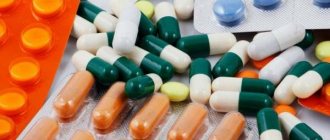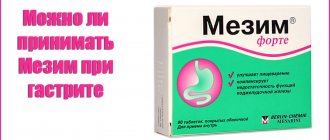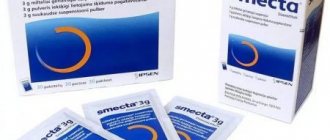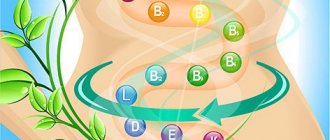De-Nol is a gastroprotective agent used for inflammatory processes in the stomach, peptic ulcers, dyspeptic functional disorders, including irritable bowel syndrome. The drug is produced in the Netherlands. Any pathology requires careful study of the instructions and consideration of contraindications. How to drink De-Nol for gastritis for a specific patient will be most accurately and correctly determined by the attending physician after examination.
Gastroenterologists successfully use the medicine to combat the infectious causative agent of gastritis - Helicobacter pylori.
Description of the dosage form
Round, biconvex, film-coated tablets, creamy white, embossed with "gbr 152" on one side and a square graphic with broken sides and rounded corners on the other, odorless or with a slight ammonia odor.
De-Nol is produced in dosage form in the form of round, biconvex, light cream, film-coated tablets. To protect against counterfeiting, each tablet has a graphic double-sided embossing “gbr 152” and a graphic design: a square with smoothed corners and breaks in the lines of the sides. A slight odor of ammonia is allowed. De-Nol tablets are packaged in blisters of 8 pcs. There are 7 or 14 blisters in a cardboard package of the drug.
The active ingredient De-Nol is a bismuth preparation: each tablet contains 304.6 mg of tripotassium bismuth decitrate, which corresponds to 120 mg of bismuth oxide. Among the auxiliary forming substances are corn starch, magnesium stearate, potassium polyacrylate, hypromellose and others in small quantities.
On the pharmacological market, the drug is released in oral form. In pharmacy chains, De-nol is presented in tablets of 56 and 112 pieces. This amount is sufficient to eliminate the symptoms of the disease and continue maintenance therapy.
Each unit in a blister is biconvex cream-colored with characteristic marks on both sides and the abbreviation of the manufacturer.
The medicine contains the active substance and auxiliary elements. The main component is colloidal bismuth subcitrate in an amount of 120 mg. The chemical compound reacts with protein structures, which, in the presence of hydrochloric acid, form chelate compounds. They concentrate in pathologically changed areas and promote epithelial regeneration.
The form is supplemented with several components. They are represented by the following adjuvants:
- corn starch;
- potassium polacriline;
- povidone;
- magnesium stearate;
- hypromellose;
- macrogol 6000.
Overdose
If the patient independently exceeds the dosage of these tablets, he may experience bismuth poisoning, which is accompanied by the following symptoms:
- disruption of the defecation process (loose stools);
- development of pain syndrome;
- a black border appears on the gums;
- attacks of nausea;
- bloating;
- vomiting reflex;
- strong rumbling, etc.
If alarming symptoms are detected, the patient should urgently contact a gastroenterologist. It is extremely important to cleanse the body of bismuth in a timely manner. Otherwise, against the background of a high concentration of this substance, the patient may develop renal failure. These measures must be carried out in a hospital, under the supervision of specialists.
De-Nol for gastritis is one of the drugs that helps not only eliminate the cause of the disease, but also relieve unpleasant symptoms. It is considered an effective remedy for inflammation of the gastric mucosa.
De-Nol is a widely used drug for the treatment of gastritis, stomach ulcers and some other gastrointestinal diseases. The main advantage is versatility. Therefore, the tablets eliminate the cause of the inflammatory process and reduce the symptoms and discomfort that worry people.
De-Nol: possible side effects
Pharmacological action - antibacterial, gastroprotective, antiulcer.
From the digestive system: nausea, vomiting, more frequent bowel movements, and constipation may occur. These phenomena are not dangerous to health and are temporary.
Allergic reactions: skin rash, skin itching.
With long-term use in high doses, encephalopathy associated with the accumulation of bismuth in the central nervous system.
For half an hour before and after taking De-Nol®, it is not recommended to take other drugs internally, as well as take food and liquids, in particular antacids, milk, fruits and fruit juices. This is due to the fact that when taken orally simultaneously, they can affect the effectiveness of De-Nol®.
Among the most common side effects of taking the drug De-Nol are reactions from the digestive system and gastrointestinal tract: nausea, dyspeptic symptoms (constipation, flatulence, increased bowel movements, less often diarrhea), decreased appetite, metallic taste in the mouth, vomiting.
Long-term treatment with high dosages is dangerous due to the development of the following conditions: nephropathy, gingivitis, arthralgia, pseudomembranous colitis, as well as encephalopathy due to the ability of bismuth preparations to accumulate in the central nervous system. Such courses are conducted only by appointment and under the supervision of a specialist.
According to the instructions for use, De-Nol is used continuously for no more than 2 months with any treatment regimen precisely because of the effect of accumulation in the tissues of the central nervous system. All side effects accompanying the use of the drug, if prescribed, occur with a fairly low frequency and go away on their own when termination of the course of treatment.
Side effect
De Nol is a drug with minimal potential for side effects. Most often this happens when the doctor’s recommendations are not followed and the rules of use are violated. In this case, negative reactions may occur, for example:
- The appearance of nausea and the urge to vomit;
- Bloating;
- Development of an allergic reaction;
- Diarrhea or constipation.
When taking the drug, it is necessary to take into account that the main part of its active substance after the therapeutic effect is excreted from the body along with urine. Therefore, in order to prevent overstrain of the kidneys, De Nol is not recommended for long-term use. Usually the course of treatment does not exceed two months.
During treatment, it is necessary to monitor the condition of the kidneys, since the medicine is eliminated from the body gradually, and renal failure may develop in acute or chronic form. There is also a risk of developing encelophopathy and vegetative-vascular dystonia.
Currently reading: How to take No-Shpa for pancreatitis: dosage, instructions and reviews
Indications and contraindications
The drug has a pronounced effect due to the medicinal properties of the main substance. De-nol has the following effects:
- anti-inflammatory;
- regenerating;
- bactericidal;
- gastrocytoprotective;
- astringent;
- enveloping.
The use of medications based on bismuth subcitrate is a mandatory direction in the fight against gastrointestinal pathology. When using the drug De-nol, the treatment of gastritis is more effective.
According to the instructions, the oral form is prescribed for the following pathological processes:
- Gastric and duodenal ulcers during exacerbation of the process.
- In case of diffuse inflammatory changes in the stomach with high acidity.
- For atrophic gastritis with low acidity.
- Chronic gastroduodenitis.
- Gastroesophageal and duodenogastric reflux.
- In the eradication scheme of Helicobacter pylori infection.
- Functional dyspepsia, which is not associated with organic damage to the digestive organs.
- Erosive and ulcerative defects of the epithelium of the intestines and stomach, including those caused by long-term use of non-hormonal drugs with anti-inflammatory effects and other medications.
- For the treatment of irritable bowel syndrome with symptoms of diarrhea.
- peptic ulcer of the stomach and duodenum in the acute phase, incl. associated with Helicobacter pylori;
- chronic gastritis and gastroduodenitis in the acute phase, incl. associated with Helicobacter pylori;
- irritable bowel syndrome, which occurs predominantly with symptoms of diarrhea;
- functional dyspepsia not associated with organic gastrointestinal diseases.
- individual intolerance to the drug;
- severe renal dysfunction;
- pregnancy;
- breastfeeding period.
De-Nol is not prescribed for use if the current or recent course of therapy includes these or other diseases containing bismuth preparations.
De-Nol is not prescribed for certain diseases, pathologies (in case of severe impairment of renal function of various etiologies), allergic reactions and individual intolerance to the components of the drug, as well as in physiological conditions that are not diseases (pregnancy, lactation) due to the probable effect on the fetus and the possibility of penetration of the active substance into breast milk.
Do not prescribe De-Nol if there are other medications containing bismuth in the current or recent course of therapy or other diseases. Contraindication to therapy with this medication is childhood (under 14 years). In rare cases, it is possible to use it from 4 years of age according to a special scheme with individual calculation of the daily dose of the drug.
So, what are the indications for treating gastritis with De-Nol?
- The drug is prescribed for ulcers (both stomach and duodenal).
- Dyspepsia (in the form of a syndrome).
- Irritation of the colon (in the form of a syndrome)
- Gastritis when leaving the acute form (into the chronic form), mainly in form B.
- Ellison syndrome.
The medicine is prescribed strictly by a doctor; self-medication is not allowed. It is usually sold in pharmacies without a prescription. It is important to understand that even such a good and useful medicine has a number of contraindications. The instructions for use contain a complete detailed list of them.
The use of the medicine by pregnant women or women during breastfeeding is strictly prohibited. This is the main contraindication of the drug. If your exacerbation occurs during pregnancy, you should not drink De-Nol. Ask to be prescribed other medications that are allowed in your situation.
Interaction with other drugs
For the treatment of gastritis or peptic ulcers, De-nol is prescribed in combination with antibacterial drugs. Several treatment regimens have been developed, including antibiotics and bismuth preparations.
In addition, De-nol is prescribed in combination with the drug Omez. The dosage and regimen are prescribed individually.
Remember, you need to take other medications at least half an hour before taking de-nol.
Interaction with alcohol
Patients often have questions about the compatibility of a drug with alcohol. The instructions for use of the drug do not contain any special instructions about the possibility of taking the drug and alcohol together. Be aware that bismuth easily forms toxic compounds with alcohol that have a detrimental effect on the liver. This leads to a ban on the simultaneous use of alcohol and bismuth preparations.
Pharmacodynamics
Antiulcer agent with bactericidal activity against Helicobacter pylori. It also has anti-inflammatory and astringent effects. In the acidic environment of the stomach, insoluble bismuth oxychloride and citrate are precipitated, and chelate compounds are formed with the protein substrate in the form of a protective film on the surface of ulcers and erosions.
By increasing the synthesis of PGE, mucus formation and bicarbonate secretion, it stimulates the activity of cytoprotective mechanisms, increases the resistance of the gastrointestinal mucosa to the effects of pepsin, hydrochloric acid, enzymes and bile salts. Leads to the accumulation of epidermal growth factor in the defect area. Reduces the activity of pepsin and pepsinogen.
Impact on the body
While taking the drug, the following processes occur in the body:
- mucus synthesis increases;
- cell regeneration (restoration) is accelerated;
- the gastric flora is restored (the mucous membrane is saturated with beneficial bacteria contained in the mucus);
- bile acids bind;
- a protective film is formed;
- inflammation is relieved;
- wounds heal (with ulcerative gastritis and gastroduodenitis);
- the irritating effect of gastric juice on the inflamed area is reduced;
- delicate enveloping;
- restoration of food digestion;
- normalization of stomach activity while stabilizing the functioning of all digestive organs;
- suppression of the growth and division of bacterial infection.
De-Nol is an astringent drug. In addition, it can have antimicrobial and gastrocytoprotective effects (protecting the gastric mucosa from chemical, mechanical and other damage).
De-Nol eliminates the acidic environment of the stomach. Due to the powerful protective properties, inflammation is quickly relieved, ulcers are scarred, and gastritis is treated quickly.
But these are not all the advantages of tablets. The substances included in the composition have a detrimental effect on the enzymatic activity of the Helicobacter bacterium. While taking it, the development of exacerbation of ulcers and the transition of gastritis to a chronic form are prevented.
How to take and how much to drink De Nol for gastritis - instructions for use
A medicine is prescribed for a duration of four to eight weeks, 1 tablet four times a day half an hour before meals and at night, or 2 tablets twice a day half an hour before meals. The patient can choose the regimen that is most convenient for him personally.
The product is not recommended for use by children under four years of age. For young patients aged 4-8 years, the dose is calculated individually according to the following scheme: 8 mg per kilogram of the child’s body weight.
At the age of 8-12 years, 1 tablet is prescribed twice a day, half an hour before meals.
It is best to drink the product with plain still water. Milk, juices, and sweet drinks are not suitable for drinking as they can weaken the absorption of the active substance included in the tablet.
Also, after taking it for 30 minutes, it is undesirable to consume any food or drink, since if other foods and liquids enter the stomach at the same time as bismuth salts, the effectiveness of the drug may be impaired.
If the doctor reveals gastritis associated with Helicobacter pylori in the patient’s tests, he will most likely prescribe De-nol in combination with antibacterial therapy.
The answer to this question can only be given by a gastroenterologist, taking into account a specific clinical case. The instructions for use of the drug indicate a period of 4 to 8 weeks.
If we are talking about complex therapy with antibacterial drugs, the duration of the treatment regimen is from one to two weeks.
You cannot change the therapy or dose of medication prescribed by your doctor on your own. Self-medication in this case can lead to a worsening of the disease and its progression.
Taking the drug for too long or using the drug in doses exceeding the highest single/highest daily dose can lead to side effects or poisoning.
This may be manifested by nausea, vomiting, bowel dysfunction in the form of constipation or diarrhea. Excessive deposition of bismuth in the central nervous system leads to progressive damage to the blood vessels of the brain - encephalopathy.
The patient should be warned by the attending physician that after starting to take the medication, the stool will turn dark, almost black.
Many insufficiently informed patients are frightened by this symptom, and this is understandable: black stool is a life-threatening sign of internal bleeding, especially if there are stomach ulcers. But in the case of taking bismuth salts, this symptom is a side effect from taking the pills.
The darkening of stool is explained by the fact that the drug is almost not absorbed into the gastrointestinal tract, but is excreted mainly in feces. In rare cases, increased pigmentation of the tongue may occur.
In case of overdose and if symptoms of poisoning appear, it is necessary to rinse the stomach as quickly as possible, give the patient activated charcoal, and call an ambulance. If you follow the instructions for taking the medicine given by your doctor, poisoning or overdose is excluded.
Therapy with De-Nol occurs as follows.
First of all, the doctor (remember that only a specialist can prescribe the drug) sets the patient up for a complete change in his regimen and diet. Now the patient sleeps 8 hours a day and eats strictly at the same time in accordance with diet number two 4 - 5 times a day. At the same time, not only unhealthy food is prohibited, but also food that is too hot or, conversely, too cold.
Therapy with De-Nol
Without such a radical change in life, taking medicine is useless! Moreover, no other drugs will help you without normalizing your diet. This is the bitter truth of gastritis; no alternative treatment regimen will work.
Dosage
Instructions for use contain all the details on dosage. Just in case, we will provide this list here. So, how do you drink De-Nol correctly, and how many tablets will you need for the course?
- Age from 4 years. The dose depends on the patient's weight (8 mg/kg). The dose is administered in two doses, which means that the child should drink 4 mg/kg at a time.
- From 8 years old, you can formalize the dose more: take one tablet in the morning and one tablet in the evening.
- For children over 12 years of age, depending on the stage of the disease and body weight, it is recommended to take 3 or 4 tablets. In the first case, it is better to take 2 in the morning and one at night; in the second, you can evenly distribute the dose and take two tablets at a time.
- Adults take 1 – 2 capsules with each meal (30 minutes before).
- The medicine should be used for several weeks (about one and a half months). In this case, the decision to complete the course is made by the doctor (and only the doctor!).
- After taking the full course, a “medicinal silence” is prescribed for several months (2 – 3) - the patient is not prescribed medications containing bismuth as active ingredients.
The general recommendation for the duration of the course should be adjusted by a doctor. You also need to discuss with him the compatibility with other drugs, including those that are not directly related to the treatment of gastritis.
Very often you can hear negative reviews like “I took De-Nol for several months, observing all the conditions, but its effect was unnoticeable, I am dissatisfied with the treatment.” Upon closer examination of the situation, it turns out that the patient was taking other medications that he forgot about or did not consider necessary to inform the doctor about. And the therapeutic effect was reduced to zero by such proximity.
IMPORTANT! Therefore, you need to know: using the drug makes sense only when all the conditions are met!
Be sure to follow the dosage and medication regimen
When taking the drug, doctors usually recommend two regimens to choose from: either take one capsule before each meal on an empty stomach 30 minutes before meals, or divide the dose into two doses and drink on an empty stomach in the morning and before bed.
The number of capsules per day may vary; in this matter, listen to the recommendations of your doctor.
Two mandatory conditions must be met: the medicine is taken only on an empty stomach and then the stomach must be empty for half an hour. You can take the tablets only with clean water. Any other liquid, as well as food, can cause the protective shell to form incorrectly, and the effect of the medicine will be incomplete.
Side effects
Even the best medications are not without side effects. In the case of De-Nol, these may be symptoms that, in principle, are not very different from the symptoms of gastritis:
- signs similar to poisoning: the patient feels sick, vomits, loses appetite;
- diarrhea develops out of the blue;
- and there may be severe constipation;
- individual reaction in the form of allergic irritation.
If side effects occur, consult your doctor to determine your next course of action. As a rule, you don’t even need to take a break from taking it, but you still need to get a consultation.
Another common, non-troubling symptom is dark-colored stool.
In case of overdose, the actions are standard: stop taking the drug, rinse the stomach, take an absorbent and consult a doctor.
Combinations
Many drugs go well with De-Nol, but each of them needs to be agreed upon separately. Antiviral and antibacterial are perfectly combined. To normalize acid secretion, Omez and others are prescribed in combination with De-Nol.
But they must be taken separately, making a difference of at least half an hour. This is a very important nuance.
Avoid alcohol completely.
It should also be mentioned that neither gastritis nor medications for it are combined with alcohol in any form. Moreover, De-Nol's interaction with alcohol can lead to very problematic deposits in the liver. And diet number two, adherence to which is necessary for successful treatment, requires an absolutely complete abstinence from any alcoholic beverages.
The drug De-Nol is an excellent choice for gastritis. It performs protective functions, facilitates the functioning of the gastrointestinal tract and creates all the necessary conditions for building the regeneration of damaged tissues. The earlier drug therapy is started, the more impressive the results will be.
When using De-Nol, it is important to act completely in accordance with your doctor's instructions. Follow all recommendations, even those that seem not very important to you (for example, hours of sleep). The success of treatment will largely depend on you.
It would be great if you share the link on your social networks so that as many people as possible can get acquainted with this useful information. We will also be glad to receive any additions if you consider this article to not fully disclose the issue of treating gastritis with the help of the drug “De-Nol”.
Bismuth subcitrate, entering the lumen of the gastrointestinal tract, almost does not penetrate into the systemic circulation. The active substance forms a special film on the surface. A small part of the drug is eliminated through the kidneys, the rest is excreted in the feces. The application regimen specified in the De-nol instructions allows you to achieve the required concentration of the main component to achieve the following results:
- Creating a protective barrier against the aggressive effects of hydrochloric acid in gastritis with high acidity.
- Increasing the regenerative capacity of the epithelium in atrophic conditions and gastritis with low acidity.
- Acceleration of healing of superficial and deep ulcerative defects with the formation of scar tissue in erosive gastritis.
- Restoring motility of the digestive tract, which reduces the likelihood of reflux gastritis.
- Stimulation of factors aimed at the production of mucus, alkaline components, components of epidermal growth in the area of inflammation. This is especially important in the case of catarrhal, hypertrophic gastritis.
- Antimicrobial effect against Helicobacter pylori.
Important! The method of application and duration of taking the drug depend on the severity of the process, the type of pathology and the presence of concomitant diseases.
When using the drug, there is a risk of side effects. Undesirable clinical consequences of administration are represented by the following symptoms:
- dyspeptic symptoms - nausea, vomiting, unstable stools, sometimes stomach pain;
- allergic manifestations - rash, itching, in severe cases - anaphylactic shock;
- a change in the color of stool, even black, due to the formation of bismuth sulfide.
Bismuth subcitrate is contraindicated in case of renal failure and a history of allergic reactions to the components of the drug. The drug is not recommended for pregnant and lactating women, given the lack of reliable information on use in this category of patients.
- Inside, with a small amount of water.
- Adults and children over 12 years old - 1 tablet. 4 times a day 30 minutes before meals and at night or 2 tablets. 2 times a day 30 minutes before meals.
- Children from 8 to 12 years old - 1 tablet. 2 times a day 30 minutes before meals.
- Children from 4 to 8 years old - at a dose of 8 mg/kg/day; The daily dosage is divided into 2 doses. Take 30 minutes before meals.
- The duration of treatment is 4–8 weeks. Over the next 8 weeks, you should not use medications containing bismuth.
- To eradicate Helicobacter pylori, it is advisable to use De-Nol® in combination with other antibacterial agents that have anti-Helicobacter activity.
Interaction and use of the drug at low pH levels
De-Nol is often used in complex therapy together with antibiotics, antimicrobial agents, and hydrochloric acid blockers (PPIs). The last group of drugs is prescribed to patients with preserved and high acidity.
At low pH levels, De-Nol is compatible with medications containing the following substances:
- metronidazole;
- furazolidone;
- amoxicillin;
- tetracycline;
- clarithromycin.
De-Nol cannot be combined with proton pump inhibitors in case of low stomach acidity. This group includes all PPIs containing the active ingredients dexlansoprazole, omeprazole, esomeprazole, lansoprazole, rabeprazole, pantoprazole. They reduce the already low pH level, which causes diarrhea, nausea, and other symptoms of dyspepsia.
If you have low acidity, you should also not take De-Nol together with:
- kombucha;
- potato juice;
- alkaline waters;
- anacidic drugs;
- alcohol;
- products and agents that lower the intragastric pH level.
With any treatment regimen, regardless of the acidity level, the course of De-Nol is 28–56 days. Teenagers and adults are allowed to drink 480 mg of bismuth per day, children aged 8–12 years – 240 mg/day. For children over 4 years of age, the dosage is calculated individually according to the regimen of 8 mg/kg/day.
Important! The tablets are taken in between meals, washed down with 50-100 ml of non-alkaline water without gas. Eating is allowed after 35 minutes. Half an hour before/after taking De Nol you should not consume milk, dairy dishes, fruit juices, or food.
Sources:
Vidal : https://www.vidal.ru/drugs/de-nol__6730 GRLS : https://grls.rosminzdrav.ru/Grls_View_v2.aspx?routingGu >
Found a mistake? Select it and press Ctrl + Enter
De-nol tablets are effective drugs for the treatment of gastritis, gastric and duodenal ulcers. The drug is readily used in gastroenterology. In addition to peptic ulcers, the drug is highly effective for a number of other diseases of the stomach and intestines. For the pathology of gastritis, De-nol is used with good results.
The main effects of the active substance of the drug are anti-inflammatory, enveloping and astringent. The effect of the drug leads to rapid restoration of the structure and normalization of the functions of the cells of the mucous membrane of the stomach and duodenum.
In terms of its chemical composition, the drug denol is a derivative of citric acid, more precisely, its bismuth salt. The element bismuth has a pronounced therapeutic effect for gastritis and ulcerative lesions.
The drug is available in tablet form and is intended for oral administration only. The package includes instructions on how to take De-nol for gastritis.
How to drink De-nol for gastritis: before or after meals
With long-term use, which has caused the accumulation of bismuth in the tissues of the central nervous system, the course of treatment is canceled. Symptomatic therapy is indicated. In acute poisoning caused by taking a dose 10 or more times higher than the average for an adult, the symptoms manifest themselves in impaired filtration function of the kidneys (renal failure).
Diagnosis is carried out on the basis of anamnesis, a laboratory blood test shows an excess of the reference values for the amount of bismuth in the blood. Therapy for acute poisoning is nonspecific; there is no antidote to bismuth preparations. Gastric lavage, saline laxatives, adsorbents, supportive treatment to restore renal function, and in severe cases, hemodialysis are indicated.
To get a positive result, follow the recommendations for using the medicine. It is necessary to drink De-nol correctly for gastritis with high acidity and low acidity, as well as other disorders of the gastrointestinal tract. Take the tablets half an hour before meals at regular intervals.
Carefully! During therapy, the use of other products containing bismuth is not allowed.
The treatment regimen and course duration are prescribed by a gastroenterologist. In each specific case, the specialist determines individually how much De-nol to take for gastritis or other pathologies. The duration of the course ranges from 4 to 8 weeks. To eliminate Helicobacter pylori infection, bismuth subcitrate should be taken for 7-14 days, and then continued after eradication for up to 6 weeks inclusive as maintenance therapy.
The drug is prescribed not only to adults. Doctors successfully use De-nol for children with gastritis and functional disorders of the digestive system. The treatment regimen has features in different age groups.
| Age | Admission rules |
| From four to eight years | Based on 8 mg per kg per day. The quantity is divided into two doses. However, no more than two tablets per day. |
| From eight to fourteen years | 1 tablet 2 times a day with a break of 12 hours |
| Over fourteen years of age | The quantity and frequency of the drug is the same as for older people - 1 tablet 4 times a day or 2 tablets 2 times a day |
Reviews from doctors and people who received them
Bismuth preparations have been used for many years to eliminate pathological conditions of the gastrointestinal tract. Thanks to its active properties, the medicine has established itself as an effective medicine. When treated with De-nol, reviews from people who have taken it for gastritis are mostly positive. Patients say that unpleasant symptoms go away within a few days after starting therapy. Most adults note a decrease in the number of relapses of gastritis when taking the drug systematically.
Experts observe excellent tolerability of bismuth subcitrate. Reviews from doctors indicate a low likelihood of adverse reactions and complications. This allows De-nol to be used in patients of different age groups. This is of great importance in the treatment of gastritis and other forms of pathology of the digestive system in children, given the limited use of alternative remedies. Several tablet release options allow you to prescribe a trial, economically affordable course of therapy.
An integrated approach to the treatment of gastritis with the inclusion of the drug De-nol guarantees high-quality and quick treatment results.
De-Nol in tablets is intended for the treatment of pathologies of the stomach and gastrointestinal tract, the destruction of Helicobacter pylori infection. According to the instructions, there are no contraindications or restrictions for taking De-Nol with low acidity. But it cannot be combined with certain medications. Therefore, a gastroenterologist should select drug combinations.
For what diseases is the drug prescribed: De-Nol for gastritis
The use of De-Nol is justified for the following diseases and pathological processes of the gastrointestinal tract:
- peptic ulcer of the stomach, duodenum with various stages of damage to the internal walls of organs during exacerbations of diseases;
- acute and chronic stages of gastritis, gastroduodenitis, including Helicobacter pylori-associated forms of diseases;
- with irritable bowel syndrome, accompanied by diarrhea as a symptom of the disease;
- with functional dyspepsia without organic etiology;
- with peptic ulcer of the stomach and duodenum;
- damage to the gastric mucosa caused by taking NSAIDs (non-steroidal anti-inflammatory drugs, including acetylsalicylic acid, ibuprofen, etc.).
Characteristics of the drug
De-Nol in tablets 120 mg refers to bismuth preparations for the treatment of diseases of the gastrointestinal tract or stomach. It promotes the healing of ulcers, relieves inflammation of the mucous membrane, and coagulates the Helicobacter pylori protein.
The use of the drug is indicated in the treatment of:
- exacerbation of gastritis, ulcers, other inflammatory, erosive diseases of the gastrointestinal tract with a high level of acidity;
- dyspepsia;
- relapse of peptic ulcers, gastroduodenitis, other inflammatory, erosive pathologies of the gastrointestinal tract with impaired gastric secretion;
- functional bowel disorder;
- for eradication of Helicobacter infection.
The therapeutic effect of De-Nol lies in its enveloping effect: the tablets react with the components of gastric juice and form a foamy substance. It covers the damaged mucous membrane with a dense layer from the inside.
Foam film formed:
- prevents irritation of the membrane by enzymes, bile, hydrochloric acid, food and/or vital activity of Helicobacter pylori;
- activates the production of PGE2, thereby improving the quality of intragastric mucus and increasing its quantity;
- prevents the movement of microbes to the stomach wall.
This gastroprotector also reduces the negative effect of pepsin on the mucous membranes in people with high acidity.
Bismuth preparation.
PDe-Nol - bismuth preparation
De Nol - a medicine for the prevention of gastritis of the stomach
If a patient’s outpatient card contains a diagnosis indicating a pathology of the stomach, marked “chronic,” the gastroenterologist may recommend taking the drug during remission to prevent relapses.
During the season of exacerbations (autumn-spring), tablets can be prescribed together with omeprazole or pantoprazle in an individual dosage for a period of 14 to 28 days.
It should be noted that to avoid exacerbations, it is important not only to take medications, but also to follow a diet and diet. Do not drink alcohol, forget about smoking, fatty and smoked foods, spices, strong coffee and tea, chocolate, marinades. Maintain a physical activity regimen and avoid stress if possible.
Following these recommendations will allow you to keep the disease in remission, and in combination with the preventive use of De-Nol, you will completely forget about stomach problems.
Prevention of the disease is a prerequisite for a positive result of therapy. Gastroenterologists recommend taking De-nol for the prevention of gastritis as an alternative if drugs that normalize the secretion of hydrochloric acid are insufficiently effective. The drug can also be combined with H2-histamine blockers and proton pump inhibitors.
Bismuth subcitrate is prescribed as planned 2 times a year in the fall and spring, taking into account the high risk of relapse during the off-season. In the absence of symptoms of the disease, the duration of therapy ranges from 10 to 14 days. If there is an exacerbation of pathology, additional diagnostics are carried out. Identification of Helicobacter pylori is an indication for an eradication course, which includes a combination of De-nol with antibiotics and medications that regulate gastric acidity. After this, the maintenance preventive course is continued for up to 6-8 weeks.
Effect of bismuth preparation on gastric pH
There is no point in treating acidity with De-Nol. Neither the annotation of the drug nor the description of the characteristics of the active substance “bismuth tripotassium dicitrate” indicate the properties of normalizing the secretory function of the stomach. Its action does not increase or decrease the pH level. But in the description of the substance it is noted that it precipitates well at a pH value equal to “4” or below this value.
Doctors practice using De-Nol in cases of high acidity to treat ulcers, erosions in the gastrointestinal tract, and eradicate Helicobacter pylori infections, since they often develop against a background of high pH levels. The drug can be prescribed in quadruple therapy regimens, which necessarily include proton pump inhibitors.
For low stomach acidity, De-Nol is used more often in monotherapy . Gastroenterologists can also prescribe co-administration with enzyme agents, if studies have revealed gastric insufficiency, and other medications.
Treatment for Helicobacter pylori infection
De-Nol is taken separately from food, liquid and other medications, especially those with antacid action. Recommended temporary pauses: 30 minutes before and 30 minutes after taking the drug.
The general course of therapy should not contain other medications with bismuth preparations due to the high total bismuth content, which can significantly increase the risk of side effects from both the gastrointestinal tract and the central nervous system.
Therapy for gastritis involves the use of several medications. The mechanism of action of bismuth subcitrate is determined by the reaction of the active substance and hydrochloric acid with the formation of a protective film. Therefore, the peculiarities of drug interactions should be taken into account.
- Between taking antacids, such as Phosphalugel, Almagel, and De-nol, a break of at least 30 minutes should be observed.
- A time interval is necessary when carrying out eradication therapy with antibiotics. This is due to a decrease in the concentration of tetracycline in the blood during treatment with bismuth.
- Proton pump inhibitors - Omeprazole, Omez, Ultop - do not interact with the substance. Therefore, medications can be taken at the same time.
- Bifiform is drunk regardless of food. The bacterial drug improves the effectiveness of eradication therapy. Combination with De-nol is allowed, but it is not used together with antibiotics; you need to take the drug after completing the course of antibacterial therapy.
- There is no interaction of bismuth with gastrointestinal motility regulators - Motilium, Trimedat. You can take De-nol at the same time as this group of drugs.
This medicine is a participant in a four-component treatment regimen for gastritis and ulcers that arise due to the colonization of the inner lining of the stomach by H. pylori
Together with antibacterial drugs, bismuth salts form colloidal particles that bind to Helicobacter. Concentrations of bismuth in the layer of gastric mucus are detrimental to many bacteria after just one dose of the drug.
It is believed that the drug inhibits the enzyme systems of H. pylori, causing the destruction of their cell membrane, which leads to death. The drug helps to disrupt the attachment of pathogenic bacteria to the epithelial lining of the inner wall of the stomach.
A 4-component complex treatment regimen is prescribed for a period of 7-14 days and includes:
- De-nol
- Metronidazole
- Tetracycline
- Omeprazole
In a large percentage of cases, taking this regimen allows you to get rid of the microbe, and therefore eliminate the causative factor in the development of gastritis. Already 1-1.5 months after the end of the course of therapy, the activity of the inflammatory process in the mucous membrane disappears, and an improvement in overall well-being occurs.
The scheme for combining medications with antibiotics and proton pump blockers was described above as one of the most effective in the treatment of Helicobacter-associated gastritis.
In other cases, the combined use of this drug and other medications should be approached carefully and only under the supervision of the attending physician.
If the patient constantly takes other medications, then it is better to drink them not at the same time as De-nol, but 30-50 minutes after taking it. Combined use may have an ambiguous effect on the body, reduce the absorption of active substances and weaken the therapeutic effect.
It has been proven that combined use with tetracycline slows down the absorption and activity of the latter.
Mechanism of therapeutic effect
The effect of De-nol is most pronounced in the treatment of peptic ulcers. When the drug enters the stomach, it forms a dense protective film on the walls, protecting damaged areas of the epithelium from the aggressive effects of hydrochloric acid and other factors, and can increase the rate of healing of ulcerative and erosive areas.
An important quality of De-nol in the treatment of gastritis and ulcers is its antibacterial effect against the causative agent of ulcers and gastritis - the microorganism Helicobacter pylori. In the 20th century, scientists proved that the mentioned microorganism often causes the development of pathology of the digestive tract.
Gastritis of the stomach
Analogs
Pharmaceutical manufacturers produce products containing bismuth under various trade names.
Pharmacies offer analogues of De-nol, which differ in form, substance content, quantity and price.
| Titles | Compound | Release form | Amount in a package | Features of application |
| Vis-nol | Bismuth subcitrate | Capsules | 30 and 100 pieces | Children from 4 years old |
| Gastro-norm | Bismuth subcitrate | Pills | 40 and 100 pieces | Children from 4 years old |
| Ulcavis | Bismuth subcitrate | Pills | 28 and 112 pieces | Children from 4 years old |
| Vikalin | Bismuth nitrate, magnesium carbonate, sodium bicarbonate, buckthorn bark, calamus rhizomes, rutin, kellin | Pills | 10 pieces | Not prescribed |
| Vikair | Bismuth nitrate, magnesium carbonate, sodium bicarbonate, buckthorn bark, calamus rhizomes | Pills | 10 pieces | Children from 7 years old |
| Ventrisol | Bismuth subcitrate | Pills | 36 pieces | Children from 4 years old |
| Novobismol | Bismuth subcitrate | Pills | 56 pieces | Children from 4 years old |
| Escape | Bismuth subcitrate | Pills | 40 pieces | Children from 4 years old |
How does an overdose manifest itself?
If the intake of tablets is disrupted or a person takes a larger dosage than prescribed by the attending physician, bismuth poisoning may develop. In case of poisoning, the following symptoms appear:
- the gums are covered with a black border;
- a feeling of nausea appears, which ends in vomiting;
- pain, rumbling, bloating appear in the stomach;
- bowel disorder.
If medical assistance is not provided in time and the body is not cleared of excess bismuth, kidney failure may develop. In this case, a person experiences general weakness of the body, sleep is disturbed, and blood pressure rises. A sign of kidney failure is urinary dysfunction (very little urine is produced). Even if one of the listed symptoms is present, you should stop taking the drug and immediately visit the hospital. While cleansing the body of bismuth, a person must be in the hospital under the supervision of doctors.











